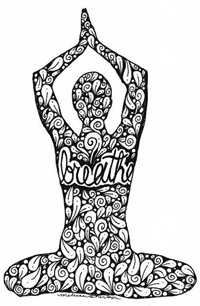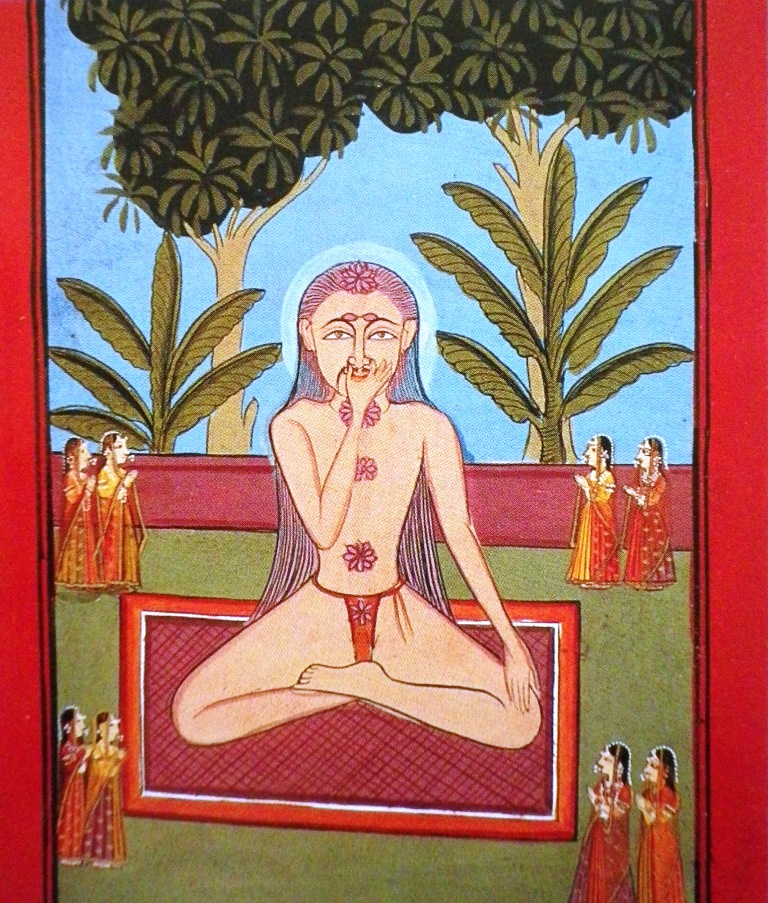THE BREATH
When the breath stops life ceases to exist.Oxygen is one of the vital elements keeping us alive. If we can inhale and absorb the correct amount of oxygen into our system then our entire being functions at peak performance. As soon as the body is under stress the lungs act as if they want to go on strike and the body holds the breath. This means that the vitality of every cell in the body is diminished. Most people are habitually lazy breathers, breathing into only one section of their lungs.
As a person inhales, oxygen passes through the windpipe into the lungs. The lungs are made up of minute air sacs covered with a webbing of tiny blood vessels. The oxygen then passes from the air sacs into the blood vessels and is transported by the red blood cells to every single cell of the body. The waste, carbon dioxide, moves in the opposite direction and is eliminated as one exhales. The lungs expand on the inhalation and contract on the exhalation. The diaphragm is the muscle situated just below the rib cage and acts like a pump, pushing up and down with each exhalation and inhalation, respectively. As the diaphragm pushes down it massages the liver, spleen and the intestines, stimulating circulation throughout the entire abdominal area.
The practice of different breathing techniques in yoga is called Pranayama. There are many different breathing exercises, each one having a different effect on the entire person. One exercise will heat you up and another one will cool you down. Most breathing exercises calm the mind and there is even one that makes me see colours.
There are times in life when things do not go altogether our way and this can affect how we feel. Attending yoga classes on a regular basis is an excellent antidote to the blues and depression. However, not everyone can or does go to yoga regularly so here are a few tips to help you. First, and most importantly, is the yoga breath (ujjayi breath). When you have control over the breath you have control over the body, the intellect and the emotions. Consider what happens when someone upsets you or makes you angry. First of all salt water comes out of your eyes and you start to shake. The level and tone of you voice rises and you probably say the wrong thing. How many times have you been upset and a week later you say to yourself “I wish I’d said…”, because it is only when your mind has cleared that you realise what you actually should have said in that situation. In moments of stress some people go so far as to throw the frying pan across the kitchen. And finally in those very stressful situations the breath catches in the back of the throat, breathing becomes difficult and you sob. If you can control the breath all else will follow and you will be in control of the situation.
YOGA BREATHING OR UJJAYI BREATH

There is a special breathing technique used in yoga. It is called the Ujjayi breath or yoga breath. Ujjyi means Victory – so this breath will help to give you victory with your postures as well as your life. This allows one exceptional control over the breath and gives an extended period of time for each inhalation and exhalation.
Every movement in yoga is accompanied by an in breath or an out breath. So the more slowly we can breath, the more slowly we can move our bodies the more beneficial the posture will be. This is why breath control is so important. The breathing is one of the foundations of yoga and once this breath is mastered the physical postures become easier.
The main characteristic of this breathing exercise is the partial closing of the windpipe with the glottis in the back of the throat. You do this by contracting the muscles at the base of your throat, near the collarbones. This acts as a brake on the inflow and outflow of air, giving you greater control over the breath. Keeping the glottis contracted, draw the breath slowly down into the back of the throat and on into the lungs. Fill the lungs from the bottom, moving up to underneath the breasts and then up to the collarbones. The air going down the back of the throat should create a slight sibilant or snoring sound. Exhale slowly in the same manner, keeping the glottis partially closed. The focus of the breath is moved from the nostrils to the back of the throat at all times during this exercise. If you experience difficulty getting the hang of this exercise then sigh the air out of your mouth and notice the feeling of air in the back of your throat. Now practise doing this with your lips closed but maintaining the focus of the breath in the throat, as opposed to in the nose. All inhalation and exhalation is through the nose and the mouth is kept closed.
Ujjayi breathing is used in almost all the yoga postures and is often used during relaxation. This breathing exercise can feel a little strange at first. Do persevere with it, however, as it is the basis of all hatha yoga and allows one to move and breathe slowly and with control. It also enhances the gaseous exchanges in the lungs.
CautionsDo not tense your shoulders, arms or jaw. Watch for this. The tension creeps in slowly when we are not observing it. It is very insidious.
Do not try to take in too much air in one breath because your shoulders will pull up and tense.
Watch that there is no stress at the edges of your breath (ie. at the end of the inhalation and exhalation).
Try to make the switchover from inhalation to exhalation as smooth as possible. This exercise should be calm and effortless.
Ensure that you exhalation is longer than your inhalation or you might become dizzy.
THE DANDELION BREATH
This is an exceedingly gentle little exercise that enhances breath control and helps to extend the exhalation. Think about a dandelion, the furry little seeds that are left after the petals have fallen off of a daisy flower. Children, the world over, blow them away. The same technique is used for this exercise.
Sit in a comfortable, upright position, with your hands folded in your lap.
Purse your lips and blow a little air out of the mouth as though you were blowing the dandelion seeds away. Continue blowing short, sharp little bursts of air out through the pursed lips until the lungs have emptied. Inhale through the nose and repeat. Remember, this is a short, sharp, little exhalation. Repeat the entire exercise six times and then take a few recovery breaths. Keep the shoulders soft for the entire duration of the exercise and ensure that you do not strain by trying to empty too much air out of the lungs.
BRAHMARI OR THE HUMMING BEE
Sit in a comfortable position. Inhale through both nostrils and exhale through the nose. Hum loudly on the exhalation, keeping your mouth closed. Keep the exhalation and the humming going for as long as it remains comfortable. Inhale through the nose without humming. Repeat this ten times.
Humming enables one to extend the exhalation and enhances the breath control. The humming also vibrates deep into the lung tissue loosening any congestion. This is an excellent exercise to practise if there is any tightness in the chest. The brahmari is exceptionally soothing and calming.
ALTERNATE NOSTRIL BREATHING OR NADI SODHANA

The following is a yoga breathing exercise that balances the two hemispheres of the brain and leaves one with a feeling of exceptional well being and calm and serene. A direct translation of Nadi Sodhana means purification of the nerves.
Sit in a comfortable position with your hands resting lightly in your lap. With your right hand feel for the end of the septum (the soft part of your nose). Fold the index and middle fingers of your right hand into the palm and place your right thumb lightly against the septum on the right side of your nose to close the right nostril. Inhale gently through the left nostril and then close the left nostril with the ring finger of the right hand. Lift the thumb and exhale through the right nostril. Keep the left nostril closed and inhale through the right nostril. Close the right nostril, open the left nostril and exhale through the left nostril. This comprises one round of alternate nostril breathing.
It is not necessary to apply pressure to the nose; a light touch is all that is required. Always start this exercise by inhaling through the left nostril so that the rhythm is left, right, right, left. This is not a harsh or a forced breath; it is a very refined, slow, smooth, gentle, breathing exercise. You should not be able to hear the breath as it leaves and enters your body. Keep the right elbow lifted away from your ribcage and keep the shoulders soft and free of tension. Do twenty rounds of alternate nostril breathing with your eyes closed and feel the difference.
As soon as you begin this exercise you will notice that one nostril is more dominant than the other. This is quite normal. The dominance changes from one nostril to the other in 45 minute cycles.
Yogis have been doing this breathing exercise for over 4 000 years. In 1983 a scientific magazine called Human Neurobiology printed an article called Science ‘Discovers’ Alternate Nostril Breathing in which it stated that there is a direct relationship between brain activity and the nasal cycle and that controlled breathing through the more congested nostril awakens the less-dominant hemisphere of the brain. It went on to say that when airflow is freer in one nostril, the opposite hemisphere is currently dominant. It is nice to know that science agrees with us.

 Return to menu
Return to menu